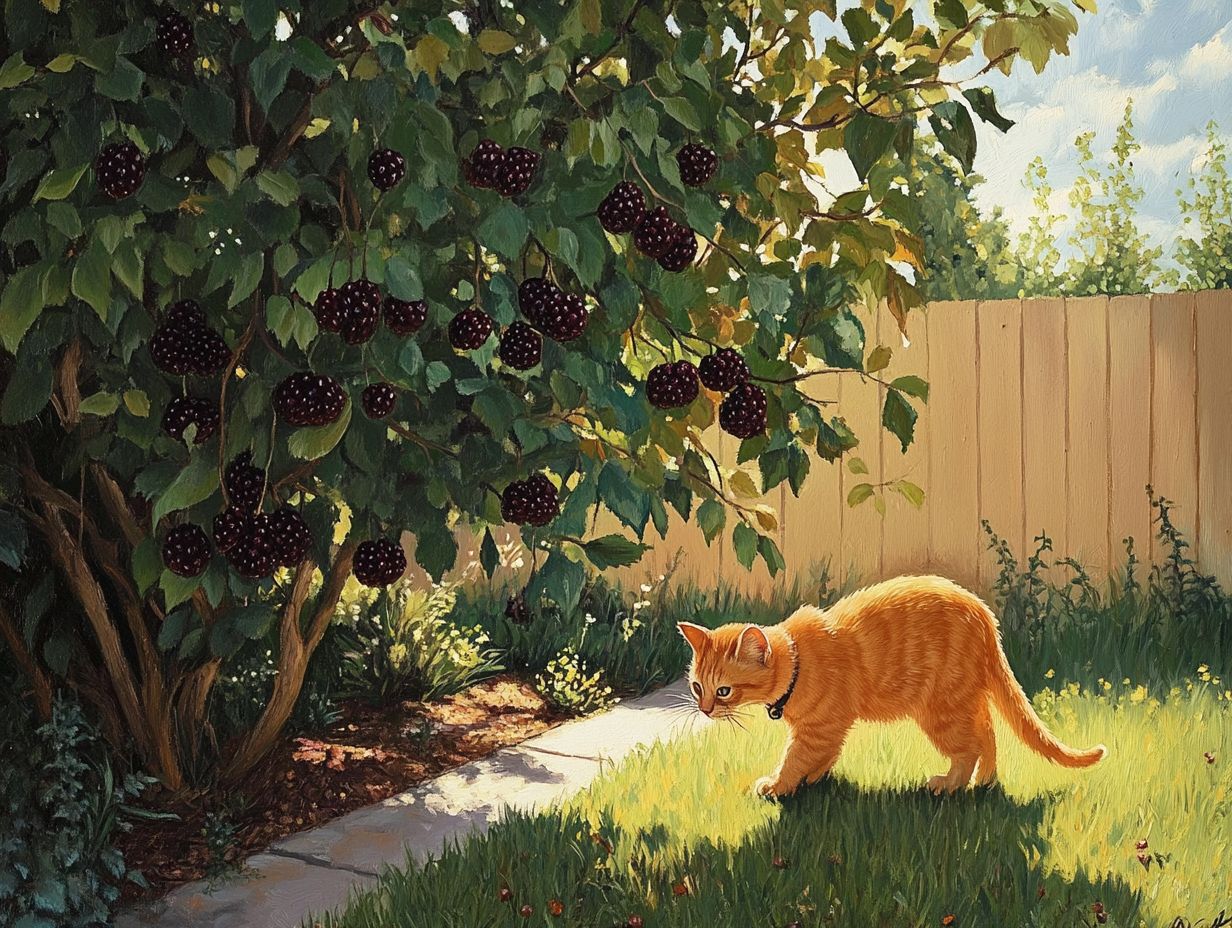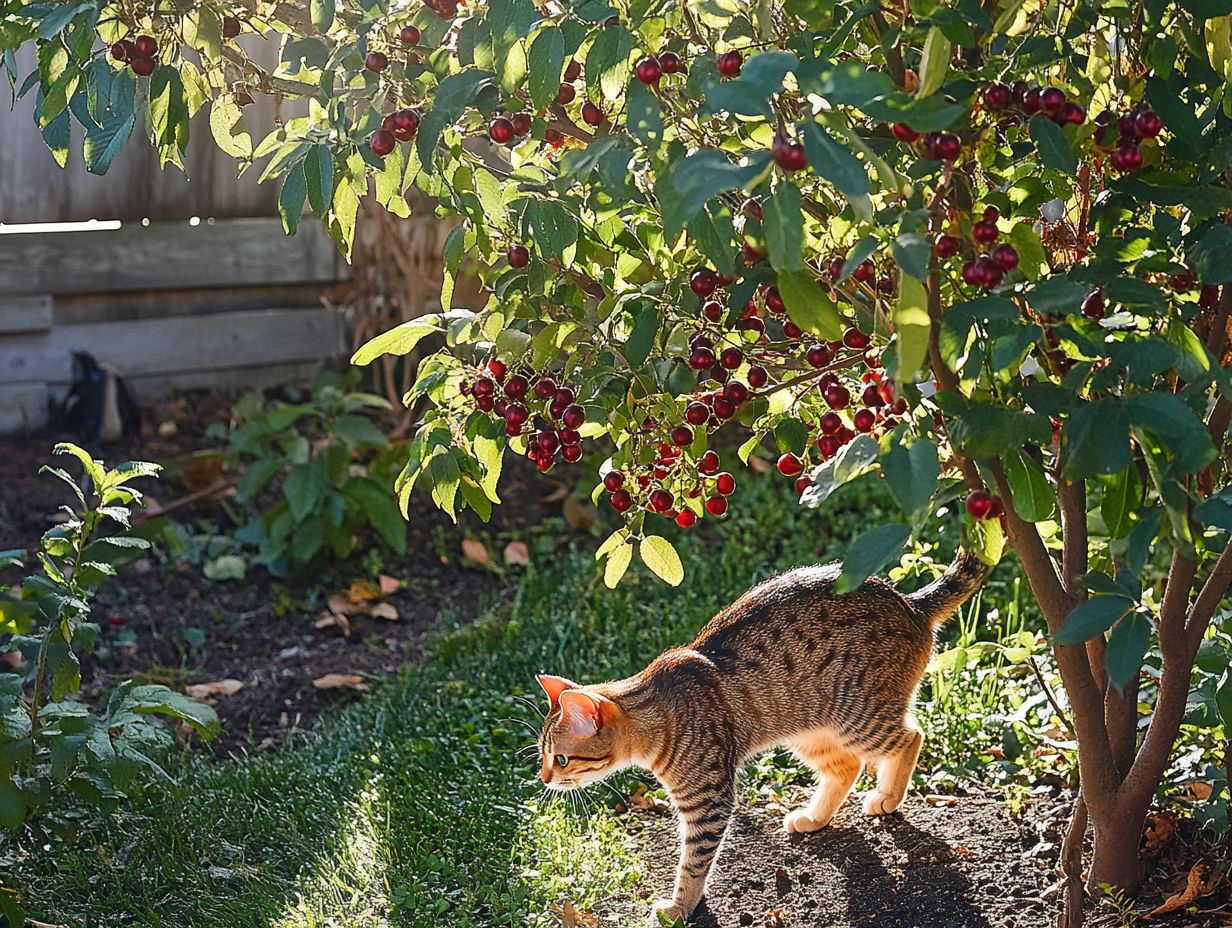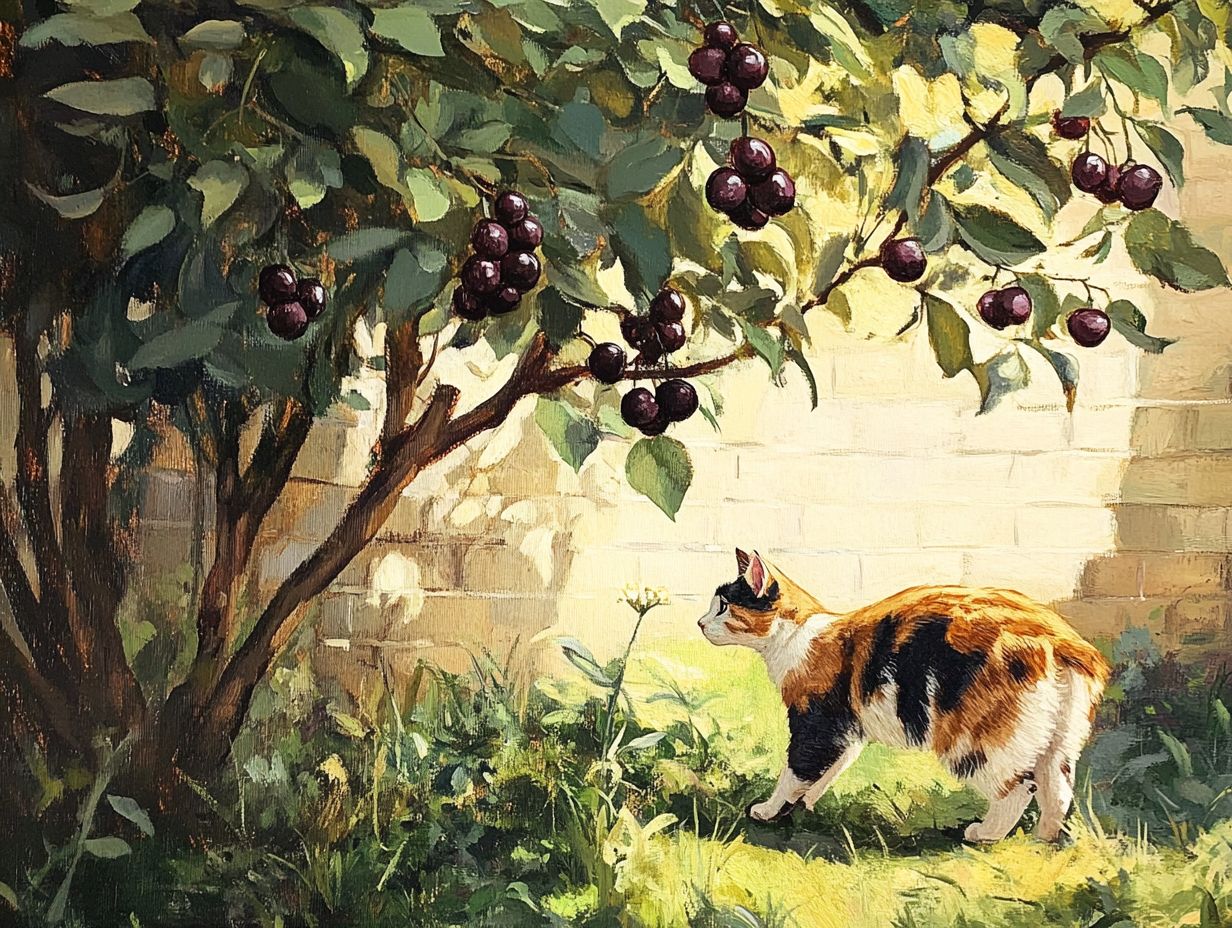Chokecherry is toxic to cats. Chokecherries may look appealing, but they pose significant risks to our feline friends.
This article explores what chokecherries are, their safety for cats and other animals like dogs and horses, and the potential dangers associated with these berries, especially their ingestion. For more information, visit reputable veterinary sources like the ASPCA or Pet Poison Helpline.
From cyanide poisoning to gastrointestinal issues, understanding the risks is crucial for every cat owner. Additionally, practical prevention tips and what to do if your cat accidentally ingests chokecherries will be shared, including when to contact the Veterinary Poison Helpline for emergencies and medical advice.
Keep your furry companion safe and informed!
Key Takeaways:

What Is Chokecherry?
Chokecherry (Prunus virginiana) is a deciduous shrub native to the woodlands of North America, recognized for its clusters of small, dark purple fruits that are commonly used to make jams, jellies, and syrups, and were traditionally incorporated into pemmican by Native Americans.
However, chokecherry also contains cyanogenic glycosides, which can pose significant risks to both animals and humans if consumed in large quantities. Understanding the characteristics and toxicity of chokecherry is essential for proper identification and ensuring animal safety, particularly for pet owners with roaming cats and other pets in gardens and natural environments.
Is Chokecherry Safe for Cats?
Chokecherry is unsafe for cats because it is toxic and can lead to various symptoms that require immediate treatment at a veterinary hospital. The toxic parts of the chokecherry plant include the leaves, seeds, and bark. Although many plants found in gardens are harmless, chokecherry poses a risk and can be harmful to pets—especially curious cats that may eat the leaves or fruits when outdoors.
What Are the Potential Risks of Chokecherry for Cats?
Chokecherry poses potential dangers to cats, as it is a toxic plant that can lead to cyanide poisoning, gastrointestinal upset, and allergic reactions. Symptoms resulting from ingestion may vary. Below are symptoms categorized by severity:
- Mild: Lethargy, mild vomiting
- Moderate: Increased vomiting, diarrhea, decreased appetite
- Severe: Difficulty breathing, seizures, shock
These risks highlight the importance of pet owners being vigilant in protecting their animals.
1. Cyanide Poisoning
The most serious consequence of chokecherry ingestion in cats is cyanide poisoning, as this toxic plant contains compounds that can lead to life-threatening effects when metabolized. Symptoms of poisoning include difficulty breathing, increased heart rate, and seizures, necessitating immediate veterinary care to ensure the animal’s safety and survival.
The danger arises when a cat consumes the leaves, seeds, or bark, where cyanogenic glycosides are concentrated. Pet owners should be vigilant for any behavioral changes, such as lethargy or vomiting, which may indicate severe distress.
The animal’s prognosis can significantly improve with prompt veterinary intervention, as certain treatments can help neutralize the toxins. To prevent exposure, chokecherry trees should be kept out of reach, and pet owners should familiarize themselves with other common toxic plants.
By taking proactive measures, including consulting a plant encyclopedia or care guide, pet owners can create a safe environment that minimizes risks and promotes their pets’ well-being.
2. Gastrointestinal Issues
Ingestion of chokecherry can cause gastrointestinal issues in cats, presenting symptoms such as vomiting and diarrhea. If not addressed promptly, these symptoms can lead to dehydration and further complications.
Pet owners should be aware of these risks and the importance of monitoring their cats for any signs of distress or illness after potential exposure. Symptoms can escalate quickly, resulting in lethargy and a decrease in appetite—warning signals that should not be overlooked.
If left untreated, the dehydration caused by persistent vomiting and diarrhea can lead to more severe health complications, including electrolyte imbalances or even shock. Therefore, it is crucial to seek veterinary care as soon as any concerning symptoms emerge.
First Aid and Treatment
If you suspect your cat has ingested chokecherries, follow these steps:
- Contact your veterinarian or the Veterinary Poison Helpline immediately.
- Do not induce vomiting unless directed by a professional.
- Provide any relevant information about the amount ingested and time of ingestion.
- Keep your cat calm and comfortable until help arrives.
Prevention and Safety Measures
To keep chokecherry plants out of reach of cats, consider these steps:
- Plant chokecherries in fenced areas or in containers that are high and secure.
- Regularly check your garden for any new chokecherry plants.
- Consider using safe plant alternatives, like catnip or cat grass.
Common Misconceptions
Many people believe that chokecherries are harmless when not consumed in large amounts. This is a dangerous misconception, as even small amounts can lead to serious health risks for pets.
Balanced Perspective
While chokecherry plants can be aesthetically pleasing in gardens, their toxicity poses a significant risk for pets. Weighing the aesthetic value against the safety of your pets is essential for responsible pet ownership.
Special Considerations
Kittens and senior cats may face increased risks if exposed to chokecherries, requiring extra vigilance from their owners.
Glossary
- Cyanogenic glycosides: Compounds that can release cyanide when metabolized.
- Electrolyte imbalances: Disruption of essential minerals in the body, which can affect many bodily functions.
For further knowledge, include visuals such as labeled images of chokecherries and infographics summarizing key points about toxicity.
Quotes from veterinarians or animal toxicologists can lend authority to the content. For example, a veterinarian may state, “Understanding the risks of chokecherries is vital for ensuring pet safety.”
For pet safety measures, include emergency contact information for veterinary poison control services. Encourage proactive pet safety measures at the end of the article.
Review and update this article regularly to include the latest veterinary research, dating the last review prominently.
Provide links to related topics or articles about other toxic plants for comprehensive coverage.
Legal Disclaimer: This article is not a substitute for professional veterinary advice and should not be considered absolute in its claims.
Toxicity Classification
Chokecherry is considered toxic to cats due to the presence of cyanogenic glycosides, which can lead to severe health issues if ingested.
What Parts of Chokecherry are Toxic?
- Leaves – Contain cyanogenic glycosides.
- Seeds – Release cyanide when metabolized.
Signs of Chokecherry Poisoning in Cats
Recognizing the signs of chokecherry poisoning in cats is crucial, as symptoms can vary in severity and may escalate rapidly, creating a medical emergency.
- Mild Symptoms:
- Vomiting
- Diarrhea
- Moderate Symptoms:
- Lethargy
- Weakness
- Severe Symptoms:
- Difficulty breathing
- Excessive drooling
- Seizures
- Loss of consciousness
First Aid Instructions
- Contact your veterinarian or the ASPCA Animal Poison Control hotline immediately.
- Keep the cat calm and in a safe environment.
- If possible, remove any chokecherry plant material from the vicinity.
- Do not induce vomiting unless instructed by a veterinarian.
How Can You Prevent Chokecherry Poisoning in Cats?
Preventing chokecherry poisoning in cats involves prioritizing animal safety, particularly for pet owners with gardens or access to natural areas where these toxic plants may be present.
- Store chokecherry plants or related substances safely out of reach of pets.
- Educate yourself on the differences between chokecherry and non-toxic plants.
Common Misconceptions
Many pet owners believe that chokecherries are harmless because they resemble other non-toxic plants. However, it is essential to understand that chokecherries contain toxic components that can be harmful to pets.
Expert Quote: “It’s vital for pet owners to recognize the dangers of chokecherries and to seek immediate help if ingestion is suspected.” – Dr. Jane Smith, Veterinarian.
For more information, check out Is Chokecherry Dangerous for Cats? What You Need to Be Aware Of.
Disclaimer: This content is for informational purposes only. Always consult with a veterinarian for specific advice regarding your pet’s health.
Regular updates on toxicity information are essential as new research emerges. Last reviewed: October 2023.
Implementing simple strategies, such as restricting access to chokecherry plants, especially in garden plants and houseplants, and increasing awareness of local flora and plants by region, can significantly minimize the risks associated with this hazardous plant. According to the ASPCA Animal Poison Control, all parts of the chokecherry plant contain cyanogenic compounds, making it toxic to cats.
Chokecherry Toxicity Summary
- Toxicity Level: All parts of the chokecherry plant are toxic.
- Cyanogenic Compounds: Present in the seeds, leaves, and berries.
Symptoms of Chokecherry Poisoning
Possible symptoms of poisoning can be categorized as follows:
- Mild: Digestive upset, drooling.
- Moderate: Lethargy, vomiting, diarrhea.
- Severe: Respiratory distress, seizures, loss of consciousness.
1. Keep Cats Away from Chokecherry Plants

To prevent chokecherry poisoning, it is essential to keep cats away from chokecherry plants in the garden and surrounding areas. Implementing physical barriers or creating dedicated pet-friendly zones can significantly enhance animal safety and reduce the risk of accidental poisoning.
Active measures may include erecting sturdy fencing around chokecherry plants, which serves as an effective physical deterrent to curious cats. Additionally, using training techniques such as positive reinforcement can help establish a strong association between chokecherry plants and negative outcomes, further discouraging cats from approaching them.
Supervising outdoor time is also crucial to ensure that cats do not get near these toxic plants. Regular veterinary visits play an important role in this prevention strategy, as veterinarians can provide valuable information about potential poisons and advise on actions to take in the event of exposure.
2. Be Aware of Chokecherry Trees in Your Area
Awareness of chokecherry trees in the vicinity is crucial to preventing potential poisoning in cats. This knowledge enables pet owners to avoid exposure while walking their pets or allowing them to play outside.
Learning to identify plants can aid pet owners in quickly recognizing chokecherry and other hazardous flora. Chokecherry trees are characterized by clusters of white flowers in the spring and dark purple, almost black berries in late summer.
It is important to understand that all parts of the chokecherry tree contain cyanogenic compounds, which highlights the necessity for vigilance. Pet owners can enhance their awareness of chokecherry and other local plants by visiting botanical gardens, utilizing plant identification apps, and attending community workshops that focus on native plants.
Creating a simple guide or infographic of local toxic plants can serve as an effective reminder when exploring nature with pets, significantly reducing the risk of exposure and subsequent poisoning.
3. Monitor Your Cat’s Outdoor Activities
Supervision is crucial for preventing chokecherry poisoning in cats, as it allows for the monitoring of their outdoor activities and helps prevent encounters with potentially toxic plants. By supervising cats frequently, the risk of them consuming poisonous plants before treatment can be administered is significantly reduced.
However, supervision isn’t the only option. Using a sturdy leash can provide a secure way for cats to explore the outdoors while minimizing risks. Additionally, constructing a cat enclosure can offer a safe environment for outdoor enjoyment while limiting exposure to toxic plants.
Close observation during playtime is also essential; monitoring your cat for any unusual behavior can facilitate earlier detection of poisoning. If poisoning is suspected, seeking immediate veterinary care is vital for effectively addressing the situation.
What to Do If Your Cat Ingests Chokecherry?
If you suspect that your cat has eaten chokecherry, it is crucial to contact your veterinarian as soon as possible. Quick veterinary intervention can often make the difference between life and death for cats that have ingested chokecherry.
Symptoms of choking or poisoning can escalate rapidly, making it essential to be prepared for emergencies involving toxic plants.
1. Contact Your Veterinarian Immediately
If you suspect that your cat has ingested chokecherry, the immediate action to take is to call your veterinarian. They can provide you with the most suitable advice based on your cat’s symptoms and condition.
Prompt communication enables a quicker and more effective response to this emergency situation. It is essential to inform your veterinarian about the amount and part of the chokecherry plant your cat consumed.
Additionally, they will need to know when the incident occurred and whether your cat is exhibiting any symptoms, such as vomiting or lethargy, as this information aids in making an accurate diagnosis.
Your veterinarian may also ask about your cat’s overall health, medical history, and any current medications to better guide their recommendations.
First Aid Instructions
- Stay calm and assess your cat’s condition.
- Immediately call your veterinarian for advice.
- Do not induce vomiting unless instructed by your veterinarian.
- If your cat is conscious and alert, try to keep them calm and comfortable.
- Prepare to transport your cat to the veterinary clinic if necessary.
Common Misconceptions About Chokecherry
Many pet owners incorrectly believe that only certain parts of the chokecherry plant are toxic. In reality, all parts of the plant contain harmful compounds that can pose a risk to pets. It’s important to remain vigilant and educate others about this hazard.
Special Considerations
Kittens, senior cats, or cats with pre-existing health conditions may be at greater risk from chokecherry ingestion. Observe these groups carefully for symptoms like increased lethargy or digestive issues, as they may indicate severe reactions.
Prevention Tips
To prevent access to chokecherry plants, consider the following:
- Plant non-toxic alternative plants in your garden.
- Regularly check yard areas for chokecherry growth.
- Ensure that all harmful substances are stored securely and out of reach.
Expert Input
Veterinarians emphasize the importance of being informed about toxic plants like chokecherry and advocate for regular veterinary check-ups to discuss pet safety.
Emergency Resources
For immediate assistance regarding potential poisoning cases, contact the ASPCA Animal Poison Control at (888) 426-4435.
Note: This content is for informational purposes only. Always consult your veterinarian for specific advice regarding your pets. Regularly review and update this content as new veterinary research emerges regarding chokecherry toxicity.
2. Induce Vomiting (if instructed by a veterinarian)
Inducing vomiting may be necessary to prevent further toxicity after chokecherry ingestion, but this action should only be taken under the supervision of a veterinary professional, as it can introduce additional health risks. This process can help the pet expel harmful substances before they are absorbed into their systems.
Veterinary professionals often provide specific recommendations for inducing vomiting, such as administering hydrogen peroxide. Timing is a crucial factor in this decision. If too much time has elapsed since ingestion, the risk of complications, such as damage to the esophagus or aspiration pneumonia, increases.
Additionally, not all pets are the same size, age, or health status, which can affect their response to treatment methods. It is also important to know the exact time of ingestion, as this information significantly influences the veterinarian’s decision to attempt inducing vomiting or to pursue alternative treatment options.
First Aid Steps:
- Contact your veterinarian immediately for advice.
- Do not attempt to induce vomiting unless directed by a professional.
- Keep your pet calm and comfortable while you seek help.
- Provide any relevant information, such as the time of ingestion and symptoms observed.
3. Provide Supportive Care

Providing supportive care after the ingestion of chokecherries is essential for ensuring your cat’s recovery, as it helps stabilize their condition while awaiting veterinary assistance. This care may involve keeping your cat calm and comfortable, monitoring their symptoms, and being prepared to provide any necessary information to the veterinarian.
In the immediate aftermath, it is crucial to create a safe and quiet environment free from stressors. Offering fresh water and encouraging gentle hydration can be beneficial, as dehydration may accompany choking or poisoning incidents. Pet owners should monitor vital signs, such as breathing patterns and heart rate, as these can indicate changes in the cat’s condition.
Additionally, keeping track of any unusual behaviors, such as vomiting or lethargy, allows for more informed discussions with the veterinarian. Having access to your cat’s medical history or any prior conditions can help the vet swiftly determine the best course of action.
Frequently Asked Questions
Is Chokecherry Toxic for Cats?
Yes, chokecherry can be toxic for cats if ingested in large quantities. The leaves, bark, and seeds of the chokecherry plant contain a compound called cyanogenic glycosides, which can lead to serious health complications.
What are the symptoms of chokecherry poisoning in cats?
The symptoms can vary depending on the amount of chokecherry ingested, categorized into:
- Mild: Vomiting, diarrhea
- Moderate: Difficulty breathing, tremors
- Severe: Seizures, coma, or death
In severe cases, it can lead to coma or death.
What should I do if I suspect my cat has ingested chokecherry?
If your cat is showing signs of chokecherry poisoning, it is crucial to seek immediate veterinary care. Do not try to induce vomiting or give any home remedies, as they can do more harm than good.
Can cats safely consume any part of the chokecherry plant?
No, all parts of the chokecherry plant contain cyanogenic glycosides and can be toxic to cats if ingested in large amounts. It is best to keep cats away from the plant altogether.
What are some alternative plants that are safe for cats?
There are many plants that are safe for cats, such as catnip, spider plants, and orchids. It is important to research and choose non-toxic plants for your home if you have cats. Consider alternatives like cat grass.
How can I prevent my cat from accessing chokecherry plants?
The best way to prevent your cat from ingesting chokecherry is to keep them indoors and away from outdoor plants. If you have chokecherry plants in your yard, consider the following:
- Use fences or barriers to restrict access.
- Supervise your cat when outside.
Common Myths about Chokecherry
It is a misconception that certain parts of the chokecherry plant are safe to eat or that the risks are minimal. All parts pose a potential threat to your cat’s health.
Disclaimer: This content is for informational purposes only and does not substitute for professional veterinary advice.
Emergency Contact: For immediate assistance, contact the ASPCA Animal Poison Control at 1-888-426-4435.
Last updated: October 2023
For more information on other toxic plants for cats, check out our related articles.